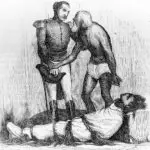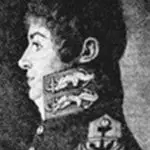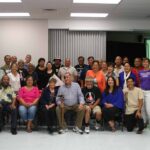CHamoru/Chamorro Sidereal Direction Terminology
Table of Contents
Share This
In 1817 Adelbert von Chamisso recorded the CHamoru/Chamorro terms for what he assumed were cardinal directions: Timi (North), Seplun (South), Manuu (East), Faniipan (West). These terms are sidereal or star directions and not completely analogous to the Western concepts of North, South, East and West. Nevertheless, these sidereal directions (of or with respect to the distant stars, i.e., the constellations or fixed stars, not the sun or planets) are fixed and not situational positions on the horizon and can easily be used as abstract cardinal directions.
The often heralded Luis de Torres was Chamisso’s primary source of information about the CHamoru language. Chamisso was a member of Otto von Kotzebue’s Russian scientific expedition to Guam. Dr. Alexander M. Kerr of the University of Guam’s Marine Laboratory, presented Chamisso’s glossary of CHamoru terms at the 2009 CHamoru Seafaring Lexicon Symposium, University of Guam, Mangilao, Guam, and reported his findings in the University of Guam’s Marine Lab Report 127.
An etymological and linguistic analysis of the archaic CHamoru direction terms at the 2014 CHamoru Seafaring Lexicon Symposium, Guam Community College, Mangilao, Guam, recommends the following spellings in modern orthography: Timek (North), Seplon (South), Manu’u (East) and Fani’ipan (West). The terms for East and South clearly suggest their sidereal roots and it seems likely that the directions West and North are also a constellation or a star.
Manu’u is a bird constellation that rises on the Eastern horizon. This word is a linguistic cognate of the CHamoru word månnok (currently used to refer to chicken), which is also the generic term for bird in Proto-Austronesian.
There are three stars in the bird constellation. The body of the bird is Rising Altair. The northern wingtip is Rising Gamma Aquila. The tip of the southern wing is Rising Beta Aquila. It seems certain that Fani’ipan is the setting bird constellation but its etymological roots are not clear.
In contrast, Carolinian navigators do not view Gamma Aquila, Altair and Beta Aquila as a bird constellation, but rather as three separate points on their sidereal compass. Carolinians view Altair as the god Mailap and the adjacent stars are his father and mother or Mailap’s North and South hand.
The sidereal direction Seplon (South) is the constellation Crux. It is commonly called the Southern Cross and looks like a diamond shaped kite. Many other Pacific Islanders identify this constellation as the diamond shape of a triggerfish. The root of the CHamoru word pulonnon (triggerfish) can be found in the sidereal direction Seplon.
Although the etymological roots are not clear, Timek , must refer to Polaris or North Star. Timek, is further substantiated by the I Fanlalai’an Oral History Project’s Research Working Team who found an additional reference with a variant spelling, Timik, in Louis Claud de Freycinet’s, An Account of the Corvette L’ Uraine’s Sojourn at the Mariana Islands, 1819.
These four sidereal directions can be generalized to the more abstract cardinal directions of North, South, East and West. Timek (North), Seplon (South), Manu’u (East), Fani’ipan (West), are no longer in general use by CHamoru speakers. These CHamoru sidereal direction terms may have fallen out of use because they were the privileged knowledge of traditional navigators or because ocean-going sailing was discouraged and sometimes even forbidden in Spanish colonial times in the Mariana Islands. Nevertheless, as late as 1722 a Catholic mission report states that CHamorus still sailed without a magnetic compass and navigated by the stars.
Terms used today are inconsistent
Today, most CHamoru speakers use the following terms: lågu, håya, kåttan, and luchan as cardinal directions, however, there are no consistent definitions of these terms. For example, most people in Saipan say lågu is West, kåttan is North, håya is East, and luchan is South. In Guam many say lågu is North, kåttan is East, håya is South and luchan is West. However, there are many village exceptions to this rule.
Before colonization these direction terms were not cardinal directions and had the following definitions: lågu meant seaward or foreign, håya meant landward or indigenous, kåttan meant to the right of seaward along the coast, and luchan meant to the left of seaward along the coast.
The aforementioned definitions of these terms are very important to helping us understand other terms that stem from them. For example, sanlagu today is predominantly used to refer to the United States. In the Spanish colonial period, sanlagu meant Spain. In addition, lågu can mean all that which is seaward, or overseas. Thus, its counterpart sanhaya can either mean, all that which is landward, or, anywhere within the Marianas. Further, fino’ håya means the indigenous language of the Mariana Islands, i.e. CHamoru. Fino’ lågu means Spanish, English, or any foreign language from overseas.
Taotao håya is an indigenous person; a native person; a CHamoru.
Taotao lågu is a foreign person; a person not of CHamoru descent.
Ga’lågu is literally, a foreign animal; foreign pet; dog. Dågon håya is a type of yam; its name suggests that it may be a native species of yam as opposed to other species that may have been introduced later.
In conclusion, to recognize that lågu, håya, kåttan and luchan are place specific directions and not cardinal directions will prevent many common misunderstandings. Further, knowledge of the four CHamoru sidereal directions can be generalized and used as cardinal directions without confusion, because they are fixed points on the horizon and not situational.
These direction terms are crucial not only for those who endeavor to restore chants and seafaring, but for the CHamoru community as a whole. In addition, this will benefit all those who will use the study of fino’ håya in efforts to rediscover elements of the CHamoru language heritage that were once thought lost.
By Jeremy Cepeda, Leonard Z. Iriarte, and Lawrence J. Cunningham
For further reading
Chamisso, Adelbert von. “Vocabularium der Dialekte Chamori (Marianen-Inseln) und von Cap, Ulea und Radack.” In Kotzebue, O. Entdeckungs-Reise in die Süd-See und nach der Berings-Straße zur Erforschung einer nordöstlichen Durchfahrt. Weimar: Gebr. Hoffmann, 1821.
Cunningham, Lawrence J. “Chamorro Directional Terminology.” In Guampedia, last modified 21 July 2021.
Freycinet, Louis Claude Desaulses de. An Account of the Corvette L’Uraine’s Sojourn at the Mariana Islands, 1819. Translated by Glynn Barratt. Saipan: Commonwealth of the Northern Mariana Islands Division of Historic Preservation, 2003.
Gladwin, Thomas. East is a Big Bird: Navigation and Logic on Puluwat Atoll. Cambridge: Harvard University Press, 1970.
Holton, Gary, Calistus Hachibmai, Ali Haleyalur, Jerry Lipka, and Donald Rubinstein. “East is Not a ‘Big Bird’: The Etymology of the Star Altair in the Carolinian Sidereal Compass.” Oceanic Linguistics 54, no. 2 (2015): 579-588.
Joseph, Alice, and Veronica F. Murray. Chamorros and Carolinians of Saipan: Personality Studies. Westport: Greenwood Press, 1971.
Lévesque, Rodrigue. History of Micronesia: A Collection of Source Documents. Vol. 5, Focus on the Mariana Mission. Québec: Lévesque Publications, 1995.
–––. History of Micronesia: A Collection of Source Documents. Vols. 12, Carolinians drift to Guam, 1715-1728. Québec: Lévesque Publications, 1998.
Solenberger, Robert R. “Recent Changes in Chamorro Direction Terminology.” Oceania 24, no. 2 (1953): 132-141.
University of Guam Marine Laboratory. Adelbert von Chamisso’s (in Kotzebue 1821) Vocabularium der dialekte Chamori. Translated and annotated by Alexander M. Kerr. Technical Report 124: 1-87. Mangilao: ML, 2009.




